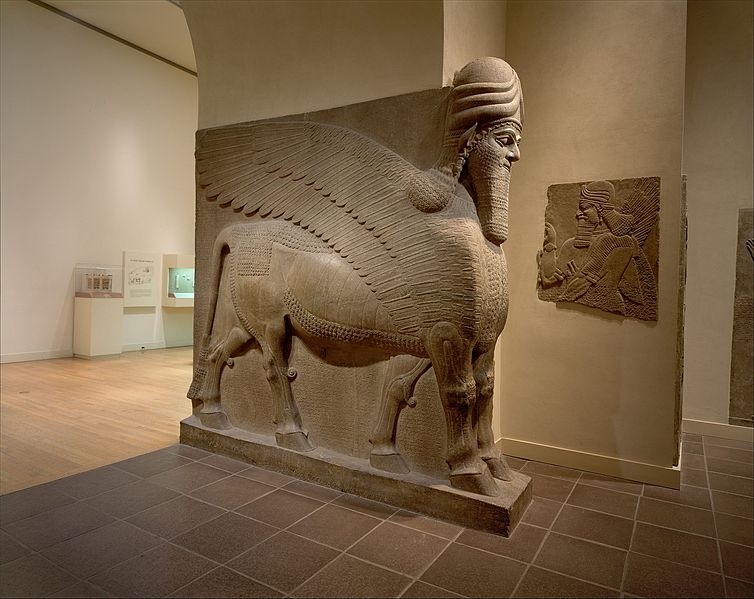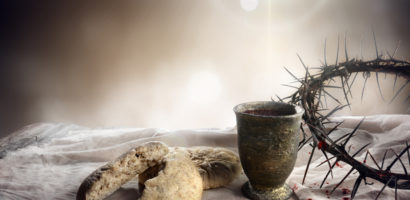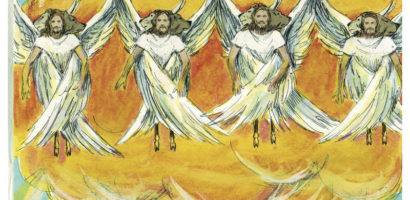The Book of Ezekiel is the third of the major prophetic books of the Hebrew Bible, following the books of Isaiah and Jeremiah. Ezekiel is a unique figure unlike most of the prophets, in that he delivered all his oracles outside the Land of Israel. He was active for roughly 25 years (593-571 BCE) as part of the community of exiled Judahites in Babylonia. Although he was not a firsthand witness, Ezekiel lived through to the greatest disaster of Israelite history until that time: the total destruction of the city of Jerusalem in 586 BCE. We do not know anything about his life prior to the age of 30 when he received his first vision by the River Chebar in the Babylonian exile. In the year 593 BCE, he received his first vision: the Vision of the Chariot, also called the Vision of the Divine Throne. This is one of the most puzzling passages in the Bible and has served as the basis for many mystical traditions about the appearance of God’s throne, such as John’s vision in Revelation 4 and the medieval Jewish merkavah literature. The theophany begins with this verse:
As I looked, a stormy wind came out of the north: a great cloud with brightness around it and fire flashing forth continually, and in the middle of the fire, something like gleaming amber. (Ezek. 1:4)
Everything is still very hazy at this point. The wind, cloud, fire are characteristic of other appearances of God in the Bible, for example, the revelation at Mount Sinai (Ex. 19:16-20) as well as Psalm 18. Ezekiel cannot see the chariot clearly yet due to all the clouds and bright light. This is one reason why this chapter uses the words “something like” (Hebrew: demut) so many times. Progressively, the vision becomes clearer in the subsequent verses. The first thing that the prophet identifies through the haze are four creatures:
In the middle of it was something like four living creatures. This was their appearance: they were of human form. (Ezek. 1:5)
Note that Ezekiel is careful not to label these sacred figures as actual animals, only semblances of animals. He uses the term “something like” or in the Hebrew demut which means a “likeness” or “appearance.” This word is used ten times in this vision. In Hebrew the “four living creatures” are arba chayot. The word chaya comes from the root חיה “to live” which is also the source of the Hebrew name חוה Chavah = Eve (Gen. 3:20). These are partly human, partly animal, bearing much in common with both the seraphim (Isa. 6:2) and the cherubim (1 Kgs. 6:23-28) charged with guarding the Holy of Holies within the Temple. Many scholars have pointed out that because Ezekiel was living in Babylonia, his vision could be based on seeing a statue called a shedu or lamassu. This is a protective deity, often depicted as a fantastic hybrid creature with a human’s head, a body of an ox or a lion, and bird’s wings. Archaeologists have discovered many examples of such statues as part of the palace gates of ancient Mesopotamian cities such as Nineveh, Persepolis and Khorsabad (Dur-Sharrukin).
Ezekiel goes on to describe these terrifying creatures in more detail:
Each had four faces, and each of them had four wings. (Ezek. 1:6)
As we eventually discover in verses 10-11, the four faces are four distinct animals, representing four divine qualities: (1) human being = intelligence, (2) lion = sovereignty, (3) ox = diligence and (4) eagle = agility. The essential point is that these are not merely wild animals, but divinely perfect composite beings who can see in all directions. They also each have four wings, similar to the seraphim in Isaiah 6 who each have six wings. But there is something a bit more complicated going on here than indicated in the English translation. Let’s take a look at the original Hebrew version of this verse:
וְאַרְבָּעָה פָנִים לְאֶחָת וְאַרְבַּע כְּנָפַיִם לְאַחַת לָהֶם
Contrary to the first clause which just says “each” (le’achat), the second clause says “each of them” (le’achat lahem). This is meant to indicate that each of the four faces had its own four wings. Thus, the grand total is: 4 creatures, 16 faces, 64 wings. Once we reach verse 7 it becomes more plausible that what Ezekiel might have in mind is a mighty Babylonian statue of the kind seen in the photograph above:
Their legs were straight, and the soles of their feet were like the sole of a calf’s foot; and they sparkled like burnished bronze. (Ezek. 1:7)
The prophet notes that the legs are straight like pillars and are shaped “like the sole of a calf’s foot,” that is, having a split hoof, as is required of all clean animals according to Deut. 14:3-8. He also mentions that they shine like “burnished bronze” (nehoshet kalal). This from the word kal meaning “light”, possibly referring to the light quick rubbing motion required to polish this type of metal. This is precisely the same material used by King Hiram of Tyre to make “the pots, the shovels, and the basins…for King Solomon for the house of the Lord” (1 Kgs. 7:45).







In reading Ezekiel 10, I wanted to note the similarities and differences with the creature in Revelation 4.
Dearest Jonathan ~ Thank You for your clear & accurate telling of the sacred experience. Your own outlook reminds me of a dear Brother in Christ Bhoddisattva The Morag Caretaker of Vajra Infinite Lineage in New South Wales. In youth Bhoddi received the Holy Roll & Word of The Most High. He has had an extraordinary life…. for those interested in ‘modern’ depictions of the Infinite Word please Bhoddi The Morag on Facebook. Bhoddi with other ‘Warrior’s of The Light Consciousness’ are cataloging and sharing their vast wisdom. His Sacred Great Artwork (possibly the greatest of its kind upon the planet) is a beautiful and expressive depiction of the sacred.
Thank You so very much for your beauty filled grace in the telling and sharing of the sacred
Blessings Light Love & Peace
This is a mysterious part of scripture that very few preachers or teachers dare to speak about. If we are to understand & appreciate this genre of literature then it is important not to omit or neglect these passages. Thank you for this blog. Paul
Great review, however, John’s vision should not be classified as “mystical tradition” because it is not, it was a clear vision.
I do not believe that the apostle John’s vision in Revelation 4 should be classified as a mystical tradition. The vision was clear
Ezekiel’s vision has been a confusing subject, although most explanations written are mystical, this article is the most plausible. I would welcome a part 2 on this topic.